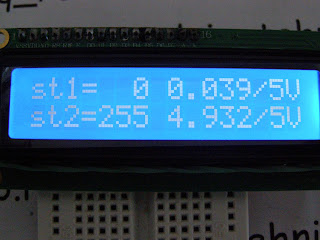So, I use info from article Controlling Volume - log pots publish on TEXAS INSTRUMENS's site.
For simple sketch and for not use more resource, I use log aproxximation, so I calculate the equations for each straights:
- for first, from 0 to 63%: y = x/5 (I know x=0 -> y=0 & x=50 -> y=10)
- for second, from 63 to 100%: y = 7/3 * x - 400/3 (I know x=70 y=30 & x=100 -> y=100)
I use same schematic like in previous article:
and I write a sketch for test more cases, this sketch is MCP4261_lin_to_log_1.ino .
I made 2 movies:
For digital potentiometer with 16 steps + mute, I have next cases:
Centralizing, we see some errors but for me there are acceptable:
and I cat continue experiments for implements this digital potentiometer in future audio project..
































